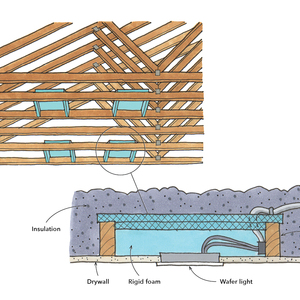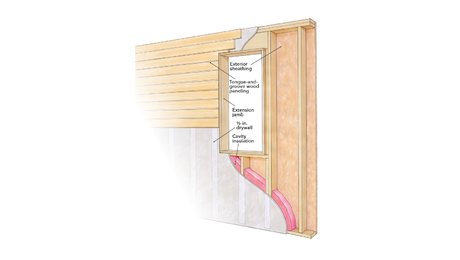Podcast 615: Spray-on WRBs, Wall Insulation, and IV Drips for Mold
Listeners write in about producer Jeff and moving heavy things and ask questions about WRBs, cavity insulation without sheathing, and IV drips for mold.
Follow the Fine Homebuilding Podcast on your favorite app. Subscribe now and don’t miss an episode:
 |
Doug shares thoughts on producer Jeff Roos. Tom suggests a good book. Dale wonders what’s being sprayed on a neighboring building. Theo asks how to insulate and air-seal without sheathing. Peter isn’t sure which side is up with his reclaimed polyiso. Jean-Charles has a novel plan for mold-fighting.
Editor Updates:
- Caleb’s intro and ProTalk Podcast.
Listener Feedback 1:
Doug writes: Hi Patrick and team,
I was shocked and saddened to learn that Jeff is no longer with FHB. I had heard about the sale and was afraid that familiar faces would be going away. I enjoyed Jeff’s contributions because, like me, he was not a building professional but a DIYer who had absorbed a lot of knowledge over the years. I remember an early episode—when Jeff was just a voice you heard occasionally—there was a discussion of how to stop knots in pine from bleeding through paint. Jeff said to use a coat of shellac, and Justin asked how he knew that. Jeff simply replied, “what other podcast do I record?”. You can learn a lot by observation. When COVID forced the format change, I saw that Jeff was closer to my age. Now Mike is the only one whose beard color matches mine.
I wish Jeff well for the future and will miss him,
Doug
Listener Feedback 2:
Tom writes: Hello FHB Podcast,
I’m just now listening to episode 607, in which you discuss a listener’s comment encouraging you to have an article about lifting a heavy ridge beam, and Patrick mentioned his fascination with the problem-solving involved in moving heavy things into position in construction.
 |
 |
There’s a delightful and short illustrated book that might be of interest here: “Moving Heavy Things” by Jan Adkins. Adkins has written and illustrated several short, delightful books, many of which look like they’re aimed at children but, like Moving Heavy Things, are suitable for adults as well. His passion is for wooden boats (a topic about which I know nothing), but his books all exude a respect for craftsmanship and practical knowledge. The closest comparison I can think of is David Macaulay. I‘m also a fan of his book Line: Typing it Up, Tying it Down.
Related Links:
Question 1: What is being sprayed on this building?
Dale writes: Hello FHB Crew —
I recognize your show is the “Fine HOMEBUILDING Podcast”—not the “Fine COMMERCIAL BUILDING Podcast—but I’ve listened to every podcast from the beginning and don’t recall any mention of the building technique shown in these photos. This is a building being erected for a school in Colorado. The exterior walls have steel studs (I don’t know the wall thickness), then pink-shaded plywood was attached to the studs. I’m guessing the plywood was pink from chemical treatment to prevent rotting. I was not able to observe the construction from the time the plywood was put in place to when the black coating was applied, but, from the photos, it appears some sort of tape was applied over the joints before the black coating was applied.
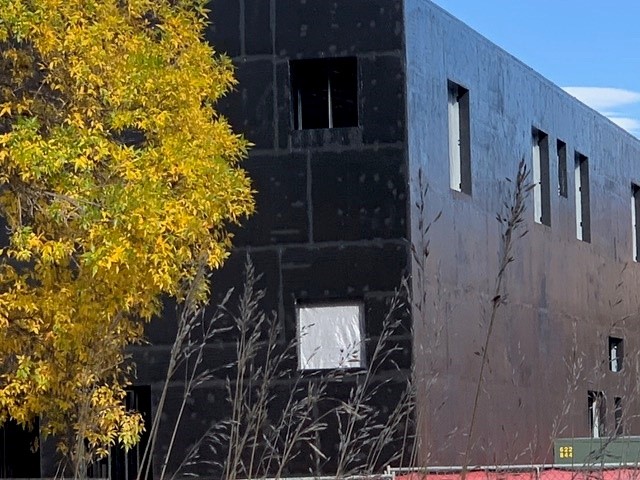 |
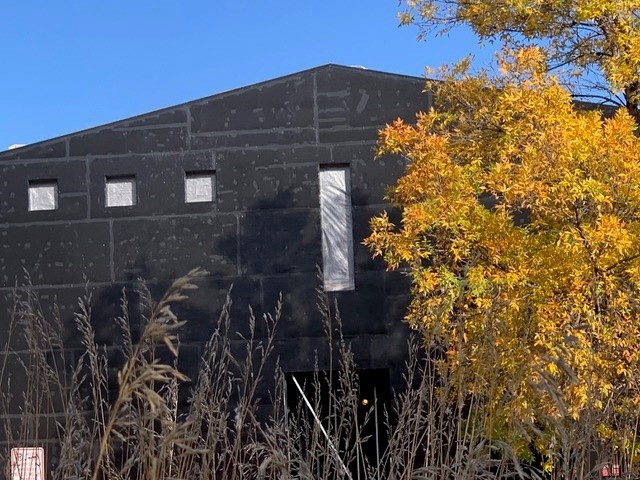 |
 |
The next photo shows workmen attaching vertical wood or engineered wood strips with screws.
Out of curiosity, what is this process, and is it ever applied to residential construction? Spraying on some sort of sealer over plywood would seem faster and easier than attaching house wrap.
Related Links:
- GBA.com: Liquid-Applied Water-Resistive Barriers
- GBA.com: Housewrap in a Can: Liquid-Applied WRBs
- How to Use a Spray-Applied Water-Resistive Barrier
- Podcast Short: Water-Resistive Barriers
- TREMCO’s EnviroDri Permeable Membrane
Question 2: How can I insulate and air-seal without sheathing?
Theo writes: Hi y’all, love the show!
I’m working on a remodel of my early ’70s single-story house near Seattle and have an insulation decision that I’d like to get your input on. Ok, it’s really a water, air, vapor barrier, and insulation decision!
It’s an interior remodel, down to the studs. The original wall structure was: horizontally applied cedar-channel lap siding, tar paper, 2×4 studs, fiberglass batts faced with metallic paper on the interior side, painted drywall. There was no sheathing, no air-sealing, and a beefy natural-gas furnace. The drywall and the (severely wind-washed) fiberglass are out of there, so the question is what to replace the insulation with. I don’t want to remove the exterior siding, so I am considering two options:
- 3.5 in. of Rockwool batts, filling the stud bays and thus pressed up against the tar paper/siding. There are some places where the tar paper was ripped, which I’d patch as much as possible with some perforated housewrap or Tyvek before installing the batts.
- 3 in. of XPS foam, cut and cobbled with canned foam around the edges and gaps. It would be placed toward the inside of the bays to allow a 1/2-in. gap between the XPS and the tar paper/siding. I could optionally remove the tar paper (mostly) from the interior of the siding, but I figure this isn’t super necessary since it’s quite vapor permeable.
I figure the nominal R-value of these two options is about the same (R-15), but the XPS offers a nice rainscreen gap between the siding and insulation, and also offers some air-sealing benefits (otherwise, my drywall has to be the only air-sealing). On the downside, it’s a pain to install and is totally vapor-closed.
Which of those options sounds best? Or is there another option that I should be considering? Should I remove the tar paper? I recognize that these questions are partly/mostly answered in Andy Engel’s article “Managing Water When Insulating Old Walls” from 2021, but I just want to make sure nothing has changed in the last couple years and that I do it right. 🙂
Some additional detail: the bulk of the area that I’m working on is on the gable end of the house and faces south…so it receives a decent amount of weather. It’s a 4/12 pitch roof and ~18-in. gable-end overhangs. Most of this area will also be getting 1/2-in. plywood sheathing on the interior to give the wall some shear strength, but I assume that doesn’t affect things much?
Thanks!
Related Links:
- How to Insulate Walls with No Sheathing
- Insulating a Wall With No Sheathing
- Six Proven Ways to Build Energy-Smart Walls
Question 3: Which way should the polyiso face?
Peter writes: Hello FHB Podcast crew.
I was quite surprised to see a very familiar ICF foundation photo pop up on my YouTube feed last Friday! Matt from TimberHP was a great guest host! Apologies if you’ve already discussed this question a gazillion times, but I’m trying to figure out whether the silver or the white side should face in or out on my assembly. I’ve attached the plan section for you, with the only change being that the 2 in. of exterior rigid will be split into two layers—1 1/2-in. reclaimed fiber-faced polyiso (a harrowing drive home indeed, photo attached) plus 1/2-in. foil-faced polysio (seams staggered and taped, of course). It’s described below from inside to out. The house is in the Boston, MA, area, climate zone 5. So, what do you all think—shiny silver facing to the exterior or interior?
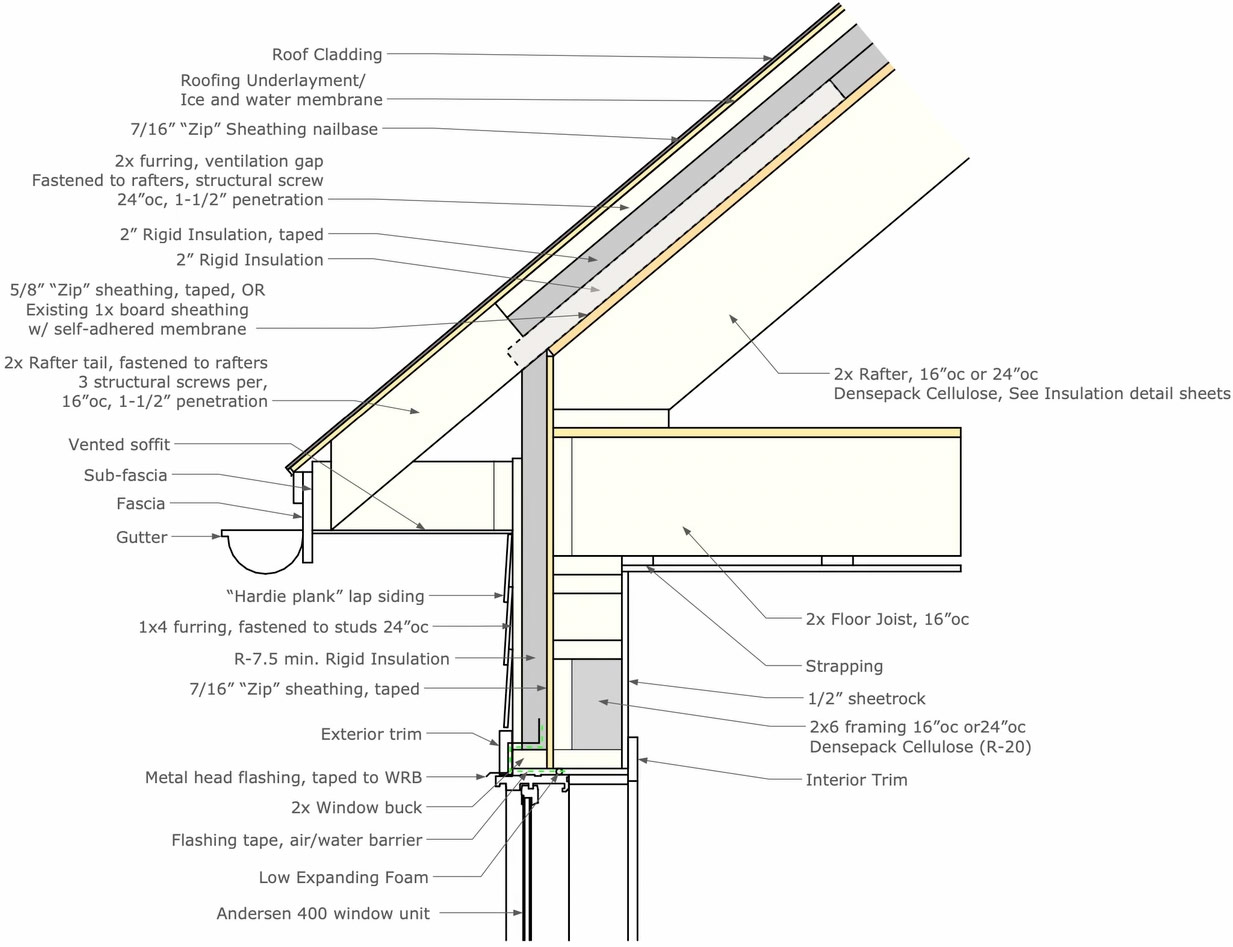 |
 |
Related Links:
Question 4: Can I remediate mold with this idea?
Jean-Charles writes:
Problem: There is mold within an interior wall on the first floor. This is confirmed by the smell and allergic response from anyone who gets too close.
This is a verrrrrrrrry old house, with several additions having been added every 75 years on average. Our homeowners insurance incentivizes adding a water-main monitoring device that will shut off the mains if there is a leak. It also tests for minor faults (dripping faucets, etc.).
For years the device would warn that up to 5 gallons per day were leaking somewhere. I tried to find the leak but could not. My best guess was the leak pertained to our elderly tenant leaving the faucet on, and there was little to be done about it. After all, if every day 5 gallons of water were leaking into the building, it would soon be apparent. Right? Right?
Well. Our tenant moved away. I shut off the water to that half of the building AND the water leak was still present?! Now the troubleshooting is in earnest. The leak is traced to a 70-year-old toilet on the second floor. The tank was misaligned and dripping in such a way that the water disappeared into the wall and then…I don’t know. No water stains, nothing to indicate water damage.
So, I shut off the water and at this point the mold becomes noticeable.
The thing to do is break wall and have at it. And surely that time will come. But for right now I had a thought—a brilliant thought. A true stroke of genius. This idea has been vetoed by my wife, and I hope you will recognize who is right.
The proposed solution: Get the mold remediation stuff, put it in the toilet tank that was leaking water, and use it to PRECISELY deliver the treatment to the affected area. A mold remediation IV drip if you will…precise targeting with no need for demolition a week before Christmas.
Thus, I ask two questions:
1. Please tell my wife I’m brilliant.
2. What’s the best stuff to denature mold spores that is suitable for application from a leaking toilet tank?
For reasons of modesty, I ask to remain anonymous.
Thanks in advance. Have a Happy holiday and best wishes for the new year!!
Related Links:
Podcast 615: Members-only Aftershow — A Carpenters’ House
Carpenter and furniture maker Caleb Carpenter talks to Patrick and Andres about the struggles and satisfaction of buying your first house.
Check out one of our latest Project Guides: Energy Retrofit!
Check out our FHB Houses:
Visit the Taunton Store • Magazine Index • Online Archive • Our First Issues • All Access

If you have any questions you would like us to dig into for a future show, shoot an email our way: fhbpodcast@taunton.com.
If we use your question we’ll send you a FHB Podcast sticker!
FHB Podcast T-shirts!
Represent your favorite podcast! Available in several styles and colors. Made from 100% cotton. Find the Podcast t-shirt and more cool products in the Fine Homebuilding Store.
| Fine Homebuilding podcast listeners can now get 20% off anything in the Taunton store, including Pretty Good House.
Use the discount code FHBPODCAST to take advantage of this special offer. |
 |
“Finally, knowledgeable people talking about building reasonably-sized, high-performance houses for normal people with real budgets!” — DanD, VA, 8/19/22, Amazon.com review |
We hope you will take advantage of a great offer for our podcast listeners: A special 20% off the discounted rate to subscribe to the Fine Homebuilding print magazine. That link goes to finehomebuilding.com/podoffer.
The show is driven by our listeners, so please subscribe and rate us on iTunes or Google Play, and if you have any questions you would like us to dig into for a future show, shoot an email our way: fhbpodcast@taunton.com. Also, be sure to follow Fine Homebuilding on Instagram, and “like” us on Facebook. Note that you can watch the show above, or on YouTube at the Fine Homebuilding YouTube Channel.
The Fine Homebuilding Podcast embodies Fine Homebuilding magazine’s commitment to the preservation of craftsmanship and the advancement of home performance in residential construction. The show is an informal but vigorous conversation about the techniques and principles that allow listeners to master their design and building challenges.
Other related links
-
- All FHB podcast show notes: FineHomebuilding.com/podcast.
- #KeepCraftAlive T-shirts and hats support scholarships for building trades students. So order some gear at KeepCraftAlive.org.
- The direct link to the online store is here.












